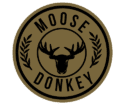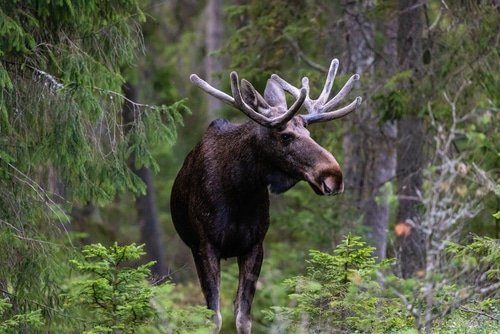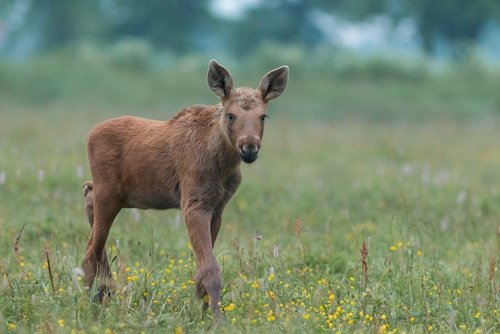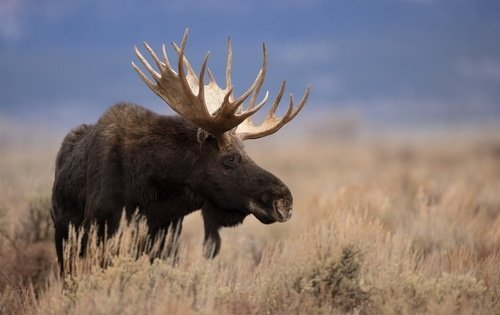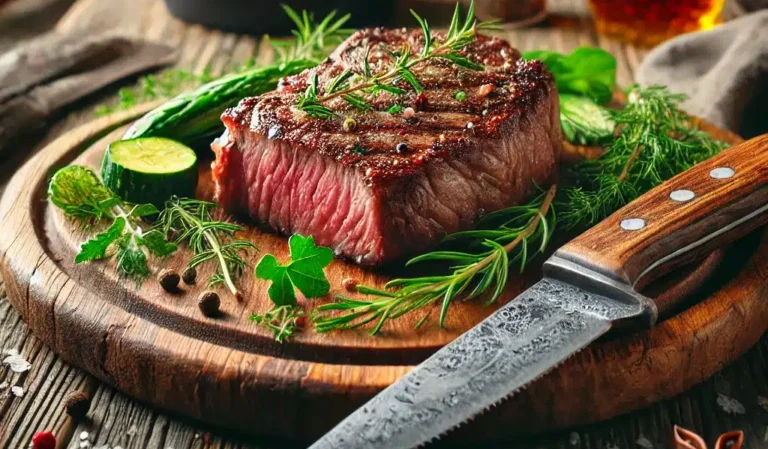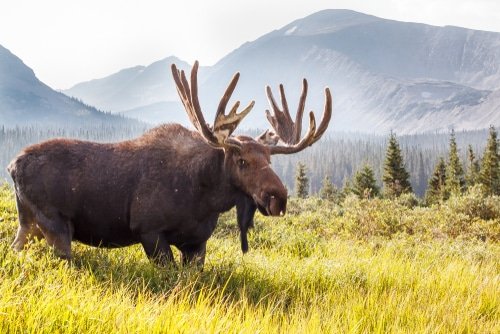The bull’s deep grunt echoes through the morning fog. Your hands grip your rifle tighter as branches crack closer and closer. This is the moment every moose hunter lives for – but are you ready for what comes next? Here are 15 moose hunting tips for your adventure.
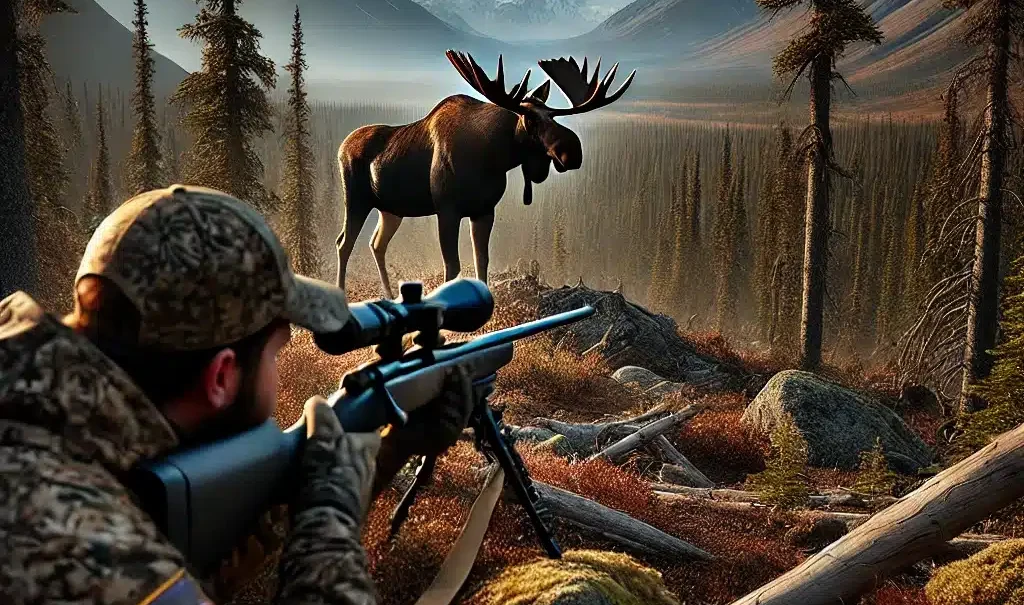
Let’s face it – moose hunting isn’t like chasing whitetails. One successful shot means enough meat to fill your freezer for a year, but you’d better know what you’re doing when that thousand-pound animal hits the ground. Whether planning your first hunt or looking to up your game, this guide cuts through the fluff and gives you the meat of what you need to know.
I’ve spent two decades chasing bulls across North America, and I’m about to share practical advice that usually only comes from expensive guide services and hard-learned lessons. There are no fancy hunting TV show tricks – just real strategies that work.
The Real Deal About Moose Hunting
- Success rates average 10-20% nationally
- Most hunters fail before they even see a bull
- Proper preparation matters more than expensive gear
- Field care makes or breaks your hunt
Moose Physical Characteristics
Bulls
- Weight: 800-1,400 pounds (varies by region)
- Height: 5-7 feet at shoulder
- Antler spread: 40-60 inches average
- Neck size: Doubles during rut
- Color: Dark brown to black, legs lighter
Cows
- Weight: 600-800 pounds
- Slightly smaller frame
- More alert than bulls
- Often with calves
- More likely to be aggressive
Moose Senses
Vision
- Poor detail recognition
- Great motion detection
- Colorblind
- 280-degree field of view
- Most sensitive to movement at dawn/dusk
Hearing
- Detect sounds 1/2 mile
- Rotating ears separately
- Most sensitive to high-pitched sounds
- Can hear underwater
- Alert to unnatural sounds
Smell
- Detection range: 1/2 mile
- Can smell through snow
- Detects human scent
- Uses scent for rutting behavior
- Most relied-upon sense
Daily Patterns and Behavior
Morning (Dawn to 10)
- Active feeding period
- Most vocal during rut
- Using open areas
- Moving from bed to feed
- Best time for calling
Midday (10 to 4)
- Bedded in thick cover
- Ruminating
- Less movement
- May feed if overcast
- Good time for still hunting
Evening (4 to Dark)
- Return to feeding areas
- Increased movement
- More vocal again
- Using water sources
- Prime hunting time
Seasonal Behavior Patterns
Spring
- Recovery from winter
- Seeking mineral sources
- Cows preparing for calving
- Bulls growing new antlers
- Following green-up
Summer
- Feeding heavily
- Using water to cool off
- Bulls in bachelor groups
- Cows with calves
- Building fat reserves
Fall (Pre-Rut)
- Increasing activity
- Bulls separating
- Establishing territories
- Rubbing velvet
- Testing dominance
Rut
- Peak hormonal activity
- Decreased feeding
- Aggressive behavior
- Maximum movement
- Most vulnerable to hunting
Post-Rut
- Return to feeding
- More cautious
- Building winter reserves
- Moving to wintering areas
- Less aggressive
Understanding Movement Patterns
Home Range
- Core area: 3-5 square miles
- Total range: up to 50 square miles
- Seasonal movements: 10-20 miles
- Daily movement: 3-5 miles
- Influenced by: Food availability, water sources, cover, weather, hunting pressure, predator activity
Where to Find Moose

Forest Edges
Characteristics
- Mixed-age timber stands
- Clear cuts 5-15 years old
- Natural meadow borders
- Forest fire recovery zones
- Logging road systems
Why They Work
- Abundant browse at reach height
- Cover meets food
- Easy travel routes
- Good visibility for bulls
- Multiple escape routes
Wetland Systems
Types to Target
- Beaver ponds
- Slow-moving streams
- Boggy meadows
- Marshy lakes
- River oxbows
Key Features
- Aquatic vegetation
- Mineral content in water
- Cooling opportunities
- Natural salt licks
- Easy access to browse
Elevation Zones
Summer Range
- 3,000-5,000 feet
- Alpine meadows
- Cool north slopes
- High basins
- Subalpine zones
Fall Range
- 2,000-4,000 feet
- Mid-slope benches
- Southern exposures
- Valley bottoms
- Transition zones
Food Sources by Season
Spring Menu
- New willow growth
- Emerging aquatic plants
- Fresh aspen buds
- Early forbs
- Tree bark
Summer Foods
- Pond lilies
- Willows
- Birch leaves
- Aquatic vegetation
- Mountain ash
Fall Selection
- Mature willows
- High-protein browse
- Mountain maple
- Red osier dogwood
- Late-season forbs
Winter Survival Foods
- Bark (multiple species)
- Cedar tips
- Dormant twigs
- Conifer needles
- Dried vegetation
Reading Moose Sign
Fresh Sign
- Tracks:
- Size: 5-8 inches long
- Depth: Indicates weight/sex
- Pattern: Shows travel direction
- Spacing: Indicates speed
- Age: Check moisture/debris
- Droppings:
- Fresh: Soft, dark, moist
- Recent: Firm, dark
- Old: Gray, dried
- Pattern: Scattered vs. concentrated
- Location: Feeding vs. traveling
- Browse Sign:
- Height: 6-10 feet up
- Clean vs. ragged cuts
- Fresh vs. old breaks
- Concentration patterns
- Species preference
Rut Sign
- Antler Rubs:
- Height: 6-8 feet
- Tree size: 2-6 inches
- Bark condition
- Direction faced
- Frequency in area
- Bull Holes:
- Size: 3-6 feet wide
- Fresh dirt thrown
- Urine smell
- Located near signposts
- Territorial marking
Essential Gear List – Comprehensive Breakdown
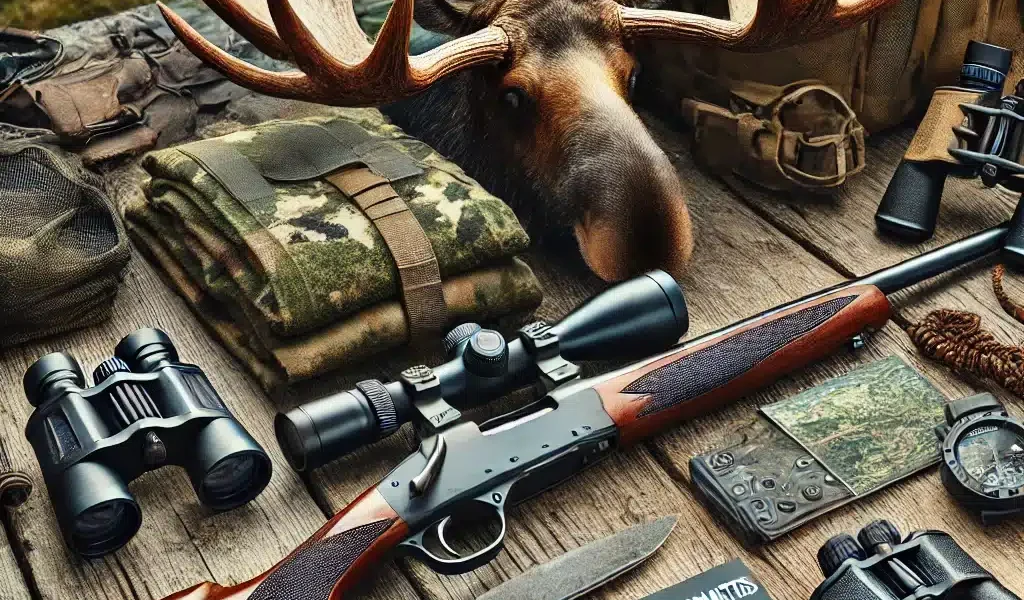
Weapons and Optics
Rifle Selection Calibers
- .30-06 (minimum)
- .300 Win Mag (ideal)
- .338 Win Mag (preferred)
- .375 H&H (maximum)
- 7mm Rem Mag (marginal)
Scope Requirements
- Magnificat: 3-9x or 2-10x
- Objective: 40-50mm
- Durability: Weather-sealed
- Eye Relief: 3.5+ inches
- Mount: Steel, not aluminum
Ammunition
- Premium bullets only
- 180-220 grain weight
- Bonded core preferred
- 40 practice rounds
- 20 hunting rounds
- Use waterproof case
Optics Package
Binoculars
- Power: 10×42 minimum
- Quality: $300+ minimum
- Features needed:
- Waterproof, fog-proof
- Rubber armored, lens cap attached
Rangefinder
- 1,000-yard minimum
- Angle compensation
- Multiple targets
- Scan mode
- Battery backup
Field Gear Essentials
Navigation
- GPS with extra batteries
- Backup compass
- Physical maps
- Unit boundary maps
- Satellite communication device
Pack System
- Main pack: 4,000+ cubic inches
- Frame strength: rated 100+ pounds
- Meat hauling capability
- External lashing points
- Waterproof cover
- Hip belt: Heavy duty
Cutting Tools
Primary Knife
- Fixed blade
- 4-6 inch blade
- Full tang
- Gut hook optional
- Easy to sharpen
Backup Knife
- Smaller fixed blade
- Different style
- Clean skinning blade
- Quick access
Saw options
- Folding saw
- Wyoming saw
- Replaceable blades
- 12-inch minimum
- Bone-cutting capable
Field Care Equipment
Game bags (6 minimum)
- Heavy duty
- Breathable material
- 72″ x 72″ minimum
- Labeled for parts
- Clean and scent-free
Processing gear
- Latex gloves (10 pairs)
- Paracord (100 feet)
- Cloth game bags
- Heavy-duty garbage bags
- Paper towels
- Hand sanitizer
Clothing System
Base Layer
- Merino wool preferred
- Synthetic backup
- Multiple weights
- No cotton
- Extra pairs
Insulation Layer
- Puffy jacket
- Fleece mid-layer
- Insulated pants
- Packable
- Quick drying
Outer Layer
- Gore-Tex or similar
- Reinforced knees/seat
- Quiet material
- Ventilation zips
- Hood required
Footwear
Primary Boots
- Waterproof
- 8″ minimum height
- Insulated
- Sturdy soles
- Break-in before hunt
Backup boots
- Different style
- Lighter weight
- Camp shoes
- River crossing capability
- Quick drying
Mastering Moose Calling Techniques – Complete Guide

Call Types and Equipment
Grunt Tube (Bulls)
- Length: 24-36 inches
- Material: Fiberglass/ plastic
- Features needed: Adjustable reed, weather resistant, shoulder strap, easy to clean, backup reed
Paddle/Antler (Bulls)
- Size: 12-18 inches
- Material: Hardwood/synthetic
- Uses: Tree raking, brush breaking, water splashing, ground scraping, challenge sounds
Cow Calls
- Megaphone style
- Cup calls
- Hand calls
- Electronic (where legal)
- Combination systems
Sound Production Techniques: Bulls
Social Grunt
- Duration: 2-3 seconds
- Intensity: Medium
- Pattern: Single call
- When to use: Early season
- How often: Every 30 minutes
Challenge Grunt
- Duration: 4-6 seconds
- Intensity: High
- Pattern: Series of 2-3
- When to use: Peak rut
- How often: Every 15-20 minutes
Aggressive Roar
- Duration: 5-8 seconds
- Intensity: Maximum
- Pattern: Single with growl
- When to use: When bull responds
- How often: Situational
Sound Production Techniques: Cows
Contact Call
- Duration: 3-4 seconds
- Intensity: Medium-low
- Pattern: Single moan
- When to use: All season
- How often: Every 20 minutes
Estrus Call
- Duration: 5-7 seconds
- Intensity: Medium
- Pattern: Whiny moan
- When to use: Peak rut
- How often: Every 10-15 minutes
Calling Sequences
Early Season (Pre-Rut)
- Start with a cow call
- Wait 15 minutes
- Soft bull grunt
- Wait 30 minutes
- Repeat if needed
- Keep volume low
- Less is more
- Focus on location calls
Peak Rut
- Begin with the cow sequence
- Add brush breaking
- Bull grunt after 10 mins
- Tree raking
- Challenge sequence
- Be more aggressive
- Add movement sounds
- Respond to any calls
- Ready for a quick approach
Late Season
- Return to cow calls
- Minimal bull sounds
- Focus on feeding areas
- Use call to stop movement
- Be patient between sequences
Common Calling Mistakes
- Overcalling
- Wrong timing
- Poor positioning
- Calling too loud
- Not being read
Advanced Calling Strategies
Multiple Position Calling
- Setup 100 yards apart
- Use different calls
- Create movement illusion
- Coordinate sequences
- Stay downwind
Call and Move
- Call then circle
- Use terrain
- Stay quiet for 20-30 minutes
- Watch back trail
- Be ready for close encounters
Hunting Tactics That Work – Comprehensive Techniques

Still Hunting Techniques
Basic Rhythm
- Move 50 yards
- Stop 10-15 minutes
- Glass surroundings
- Listen 5 minutes
- Check wind direction
Terrain Use
- Stay below skyline
- Use shadow edges
- Follow contours
- Avoid noisy ground
- Keep escape routes open
Weather Factors
- Wind in face
- Light rain ideal
- Overcast preferred
- Avoid calm days
- Use wind noise
Spot and Stalk Methods: Glassing Technique
Systematic Search
- Grid pattern
- Near to far
- Bottom to top
- Use landmarks
- Document sightings
Key Areas to Glass
- Edge habitat
- Water sources
- Natural openings
- Recent burns
- Logged areas
Planning Phase
- Map multiple routes
- Note wind direction
- Identify landmarks
- Plan backup approaches
- Consider shoot position
Movement Rules
- Stay invisible
- Test wind frequently
- Move only when the animal is feeding, behind cover, looking away, moving, distracted
Stand Hunting: Location Selection and Timing
Primary Setups
- Trail intersections
- Feeding areas
- Travel corridors
- Rut zones
- Water sources
Stand Requirements
- Multiple escape routes
- Good visibility
- Solid shooting rest
- Quiet footing
- Scent control
Morning Stand
- In position pre-dawn
- Stay until 10:00
- Call every 30 minutes
- Watch wind
- Stay alert for close movement
Evening Stand
- Position by 3:00 PM
- Stay until dark
- Increase calling last hour
- Watch thermal currents
- Be ready for quick shots
Advanced Tactics
Pinch Points
- Identify natural funnels
- Set up downwind
- Watch escape routes
- Use terrain features
- Have backup position
Water Hunting
- Early morning/late eve
- Check for tracks
- Listen for splashing
- Use aquatic vegetation
- Consider water approach
Calling Setup
- Back to thick cover
- Clear shooting lanes
- Multiple gun rests
- Quiet setting
- Good visibility
Shot Placement

Shot Placement Anatomy: Vital Zone
Heart/Lung Area
- Location: Lower 1/3 behind shoulder
- Size: 18″ diameter
- Best angle: Broadside
- Depth: 8-12 inches
- Landmarks: Front leg position, shoulder blade, body crease, chest line, last rib
Critical Angles Broadside
- Primary aim: 4″ behind shoulder
- Alternative: Point of shoulder
- Height: Lower 1/3
- Margin of error: 6 inches
- Success rate: Highest
Quartering Away
- Aim point: Opposite shoulder
- Angle adjustment: Forward 1/3
- Height: Mid-body
- Penetration needed: 30+ inches
- Success rate: Good
Quartering Toward
- Not recommended
- Limited vital access
- High risk of poor penetration
- Difficult blood trailing
- Low success rate
Shot Execution: Range Considerations
0-100 yards
- Point blank range
- No holdover needed
- Maximum accuracy
- Best blood trails
- Highest success
100-200 yards
- Know bullet drop
- Account for wind
- Use solid rest
- Confirm range twice
- Wait for perfect shot
200+ yards
- Not recommended
- Too many variables
- Poor angle assessment
- Difficult follow-up
- High wound rate
Follow-Up Procedures
Immediate Actions
- Mark your shooting position
- Note animal’s direction
- Watch as long as possible
- Listen for crash
- Stay put 30 minutes
Blood Trailing: First Hour
- Mark last known position
- Find first blood
- Mark trail with tape
- Note blood color/type
- Document direction
Blood Types
Bright Red
- Muscle hit
- Good trailing
- Animal may go far
- Follow carefully
- May need tracking dog
Dark Red/Bubbles
- Lung hit
- Short tracking job
- Listen carefully
- Circle downwind
- Usually under 200 yards
Dark Red/Chunks
- Heart/liver
- Fatal hit
- May run 100 yards
- Heavy blood
- Follow quickly
Recovery Strategy
Initial Search
- Grid pattern
- Mark last blood
- Use multiple searchers
- Keep noise down
- Look for: Broken branches, hair, tracks, disturbed ground, blood spots
Lost Trail Protocol
- Circle last sign
- Expand search
- Use tracking dog
- Mark all sign
- Consider: Water sources, thick cover, downhill routes, escape paths, bedding areas
Field Care and Processing
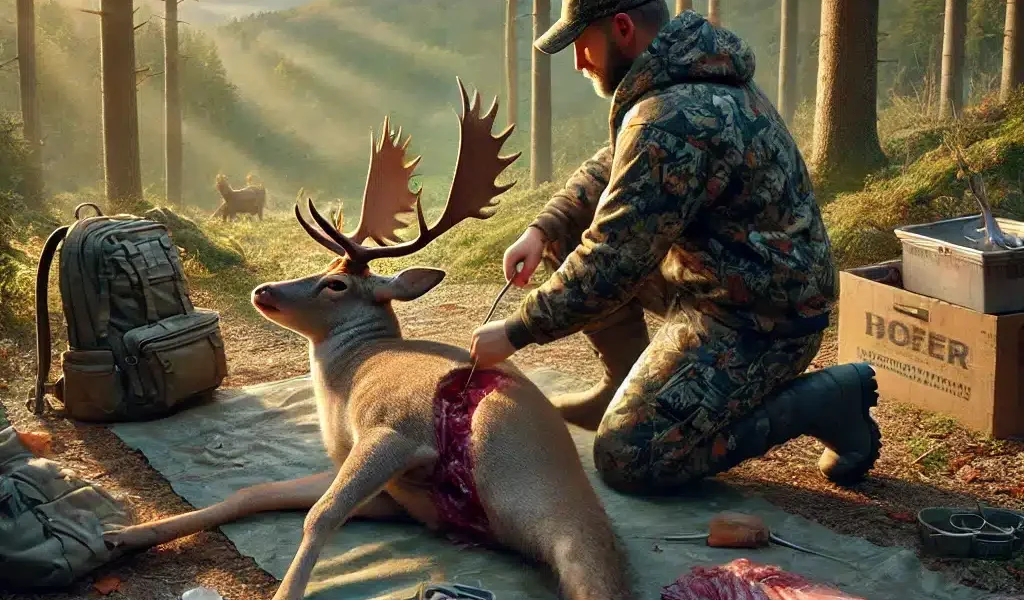
Immediate Action Steps: First 30 Minutes
Tag and Photo Documentation
- Fill out tag
- Take required photos
- Document location
- Note time down
- Contact authorities if needed
Initial Assessment
- Check temperature
- Plan approach
- Gather equipment
- Assign tasks
- Consider extraction plan
Temperature Management
Critical Time Windows
- Under 40°F: 12 hours
- 40-60°F: 6 hours
- Over 60°F: 3 hours
Cooling Strategies
Hot Weather (Above 60°F)
- Immediate skinning
- Remove organs ASAP
- Quarter immediately
- Get meat elevated
- Use shade/natural cooling
Cold Weather
- More time available
- Keep quarters large
- Use snow/cold water
- Allow natural cooling
- Prevent freezing
Field Dressing Process: Step-by-Step Guide
Positioning
- Uphill when possible
- On back
- Legs spread
- Support blocks
- Clear workspace
Initial Cuts
- Circle genitals
- Split hide carefully
- Avoid puncturing organs
- Work up to sternum
- Watch blade depth
Organ Removal
- Cut diaphragm
- Free esophagus
- Roll organs out
- Save heart/liver
- Remove windpipe
Quartering Process
Skinning
Start at legs
Work methodically
Keep meat clean
Save cape if needed
Remove hide completely
Front Quarters
- Find joint
- Follow shoulder blade
- Cut connecting tissue
- Leave leg attached
- Clean thoroughly
Hindquarters
- Find hip joint
- Cut around socket
- Follow natural seams
- Keep bone in
- Remove cleanly
Backstraps
- Start at rump
- Follow spine
- Keep close to the bone
- Full-length removal
- Clean thoroughly
Meat Care and Storage
Game Bag System
- Label each bag
- Keep quarters separate
- Allow airflow
- Keep clean
- Hang properly
Cooling Methods
- Hang in shade
- Allow circulation
- Check regularly
- Protect from insects
- Monitor temperature
Snow/Ice
- Pack in clean snow
- Use ice blocks
- Monitor melt
- Keep dry
- Change as needed
Transport and Storage – Field to Freezer Guide
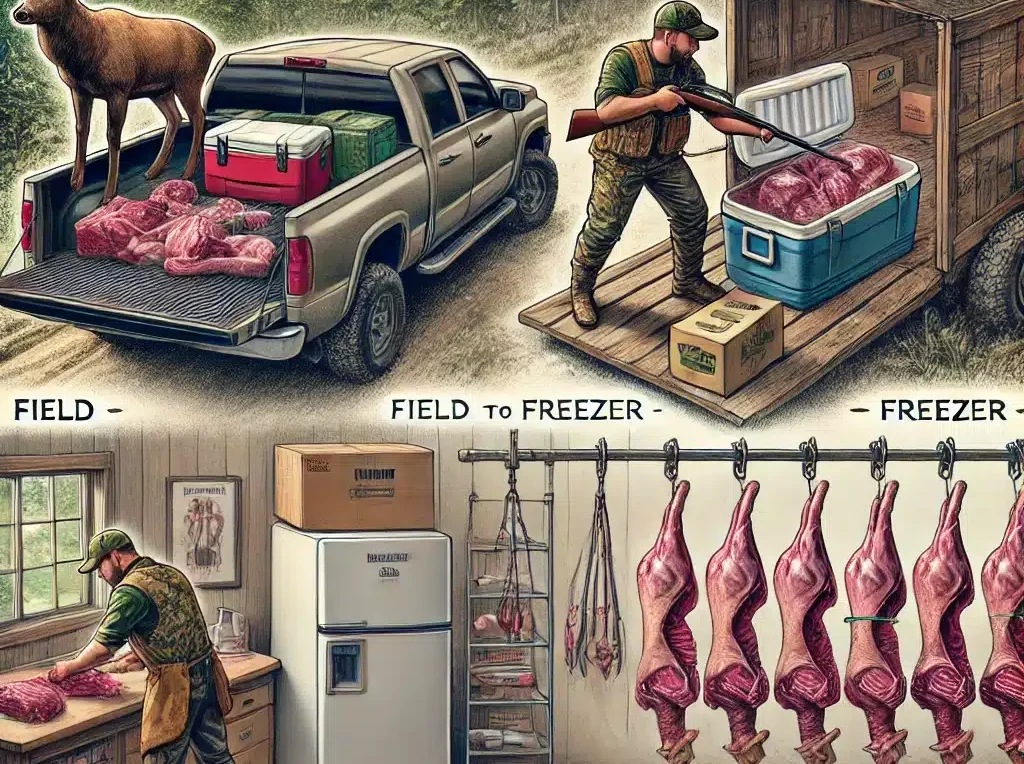
Field Transport
Frame Pack Method
- Weight distribution: 70/30
- Maximum load: 100 lbs
- Rest every 45 minutes
- Alternate carriers
- Equipment needed: External frame pack, compression straps, padding material, load lifters, hip belt support
Team Carry Options
- Pole carry system
- Two-person method
- Relay system
- Rest stations
- Equipment sharing
Vehicle Transport
Truck Bed
- Keep cool
- Allow airflow
- Clean surface
- Ice if needed
- Cover from sun
Trailer
- Proper ventilation
- Secure load
- Temperature control
- Easy access
- Clean environment
Processing Preparation: Temperature Control
Short Term (1-3 days)
- 34-38°F ideal
- Monitor hourly
- Rotate quarters
- Check game bags
- Maintain airflow
Long Term (3+ days)
- Commercial storage
- Process immediately
- Freeze quarters
- Monitor quality
- Document timing
Aging Process Considerations
- Temperature control
- Humidity levels
- Air circulation
- Contamination prevention
- Time management
Aging Timeline
- 5-7 days: Minimum
- 10-14 days: Ideal
- 14+ days: Monitor closely
Home Processing
Tools Needed
- Sharp knives (multiple)
- Cutting boards
- Bone saw
- Meat grinder
- Vacuum sealer
Work Area
- Clean surface
- Good lighting
- Temperature control
- Water access
- Proper drainage
Cut Selection
- Backstrap steaks
- Round steaks
- Roasts
- Stew meat
- Ground meat
Storage Methods
Freezer Preparation
- Vacuum seal all cuts
- Label clearly: Cut type, date, weight, aging time, storage recommendations
Long-term Storage Temp
- 0°F or below
- Monitor regularly, check seals
- Rotate stock, use within 12 months
Conclusion and Special Considerations
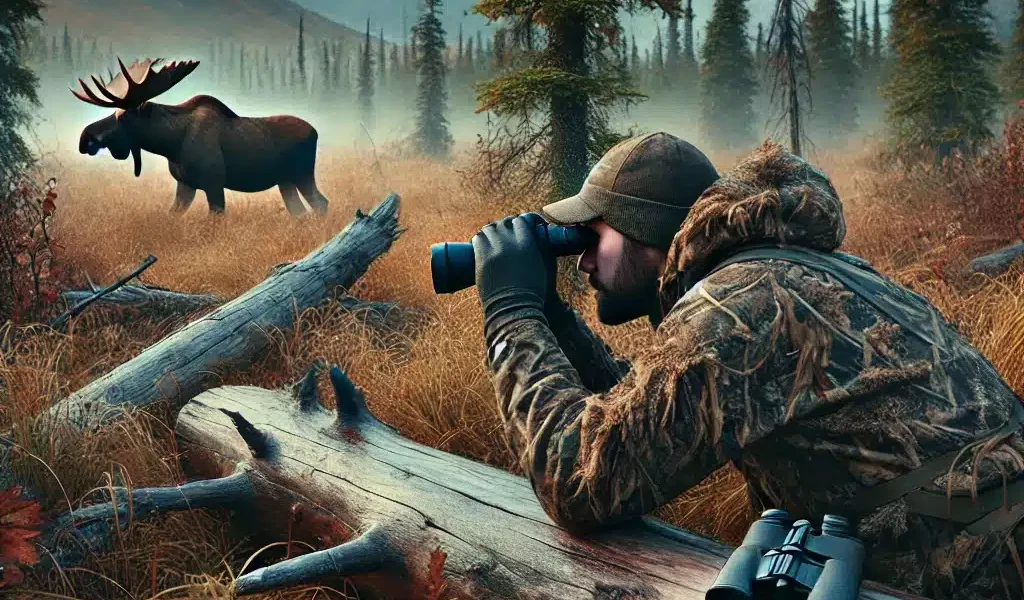
Success Factors Summary
Preparation
- Physical conditioning
- Equipment readiness
- Mental preparation
- Area knowledge
- Team coordination
Execution
- Patience in the field
- Shot selection
- Quick field care
- Proper meat handling
- Efficient transport
Weather Challenges
Rain/Snow
- Keep ammunition dry
- Extra clothing
- Shelter options
- Fire starting materials
- Emergency gear
Heat
- Cooling strategies
- Extra game bags
- Ice/cooling plans
- Processing priority
- Transport timing
Team Management
Role Assignment
- Primary shooter
- Caller
- Pack out team
- Field dressing
- Camp support
Communication
- Hand signals
- Meeting points
- Emergency plans
- Time checks
- Progress updates
Safety Protocols
Emergency Preparedness
- First aid kit
- GPS/satellite phone
- Emergency shelter
- Fire starting kit
- Signal devices
Contact Plan
- Check-in times
- Emergency numbers
- Meeting locations
- Backup plans
- Local resources
Success Checklist
Pre-Hunt
- Equipment check
- Area scouting
- Team briefing
- Weather check
- Permit verification
During Hunt
- Safety first
- Patience always
- Team communication
- Weather awareness
- Meat care priority
Post-Hunt
Proper documentation
Equipment cleaning
Meat processing
Success/failure analysis
Lesson documentation
Common Mistakes to Avoid
Field Errors
- Rushing shots
- Poor preparation
- Inadequate cooling
- Bad shot placement
- Equipment failure
Processing Errors
- Delayed care
- Poor temperature control
- Contamination
- Improper aging
- Bad packaging
Future Planning
Record Keeping
Hunt locations
Weather conditions
Success patterns
Equipment needs
Team performance
Improvement Areas
- Shooting practice
- Physical conditioning
- Gear upgrades
- Area knowledge
- Technique refinement
Final Thoughts: The Real Deal About Moose Hunting

Listen up – successful moose hunting isn’t about expensive gear or lucky shots.
It comes down to this
- Preparation beats luck every time
- Shot placement is everything
- The real work starts after the trigger pull
- Meat care can’t wait
- Success means learning from every hunt
Takeaways
- Do your homework before the season
- Stay patient in the field
- Have a solid meat care plan
